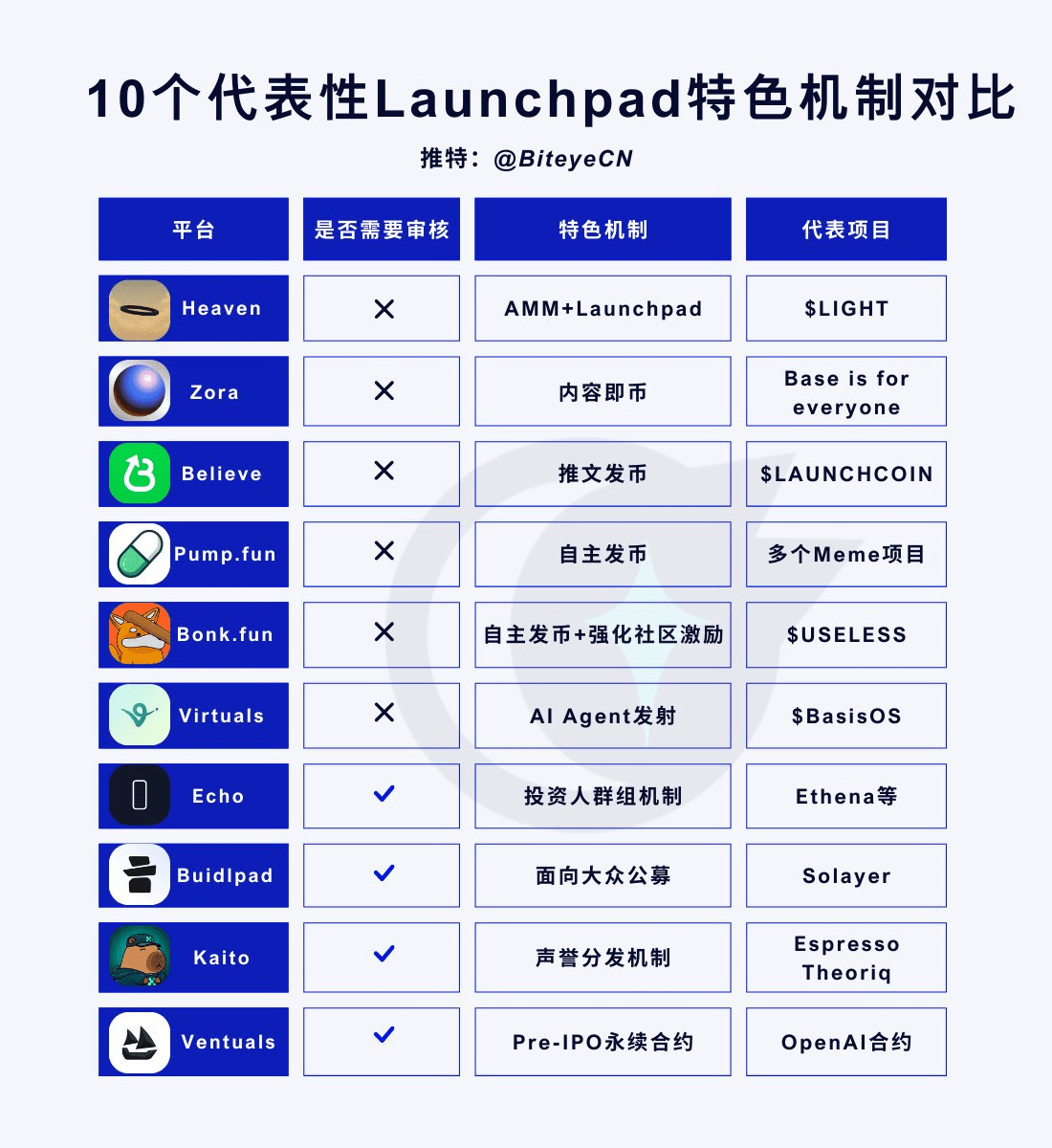In this bull market, the motivation for issuing coins has been thoroughly penetrated. From Meme coins to AI agents, even Pre-IPO stocks are being fully issued. We selected 10 landmark platforms, dissected their unique mechanisms and performance, and discussed how retail investors should play to seize opportunities while avoiding pitfalls.

01 Permissionless platforms
1. Heaven
Mechanism: Heaven is a newly emerging AMM + Launchpad platform, integrating issuance and trading, with projects not needing to migrate to external DEXs. All transaction fees are retained on the platform for buyback and destruction of $LIGHT, and holders can directly share dividends. In contrast, while Pump.fun is profitable, it lacks this feedback mechanism.
Performance: After $LIGHT launched, it rose continuously for a week, with a market cap exceeding 100 million USD, and a sustained buyback and destruction mechanism greatly enhanced market confidence.
2. Zora
Mechanism: Zora is a social + creator economy protocol on the Base chain, where the core gameplay is to create content = create projects. When you post a text or image, it will automatically launch assets.
Performance: $ZORA once rose 10 times over 20 consecutive days, and in April this year, the official account of Coinbase Base chain released the phrase 'Base is for everyone', leading to the automatic minting of assets. Many thought it was official, resulting in a rush that inflated the market cap to 17 million USD, which then quickly fell back by 90%.
3. Believe
Mechanism: Believe was formerly known as Clout, initially focused on the 'celebrity circle', and later shifted towards social assetization, popularizing the ICM narrative. Users only need to post a tweet with @launchcoin on Twitter to automatically generate a project. After the market capitalization exceeds 100,000 USD, it will automatically list on trading platforms like Meteora.
Performance: $LAUNCHCOIN once soared 50 times in 3 days, with a market cap reaching 300 million USD. The former $PASTERNAK was close to zero at one point, but after rebranding, it surged from 1 million to 22 million within 24 hours. Many platform projects have also offered retail investors opportunities over ten times.
4. Pump.fun
Mechanism: Pump.fun can be considered the pioneer of on-chain asset issuance, directly exploding the Meme gameplay. By uploading a name, logo, description, etc., it can automatically generate contracts and initial liquidity pools. The pricing uses a joint curve model, where the more people buy, the higher the price. When the market cap reaches a specified threshold, the smart contract will also automatically migrate liquidity to external DEXs, seamlessly accessing a larger market.
Performance: As the number one permissionless platform, numerous well-known Meme projects have emerged from Pump.fun, and there’s no need to elaborate further.
5. Bonk.fun
Mechanism: The BONK community launched a platform in April 2025, with gameplay similar to Pump.fun but emphasizing community dividends. Transaction fees will partially be returned to BONK holders and ecological builders, strengthening community incentives.
Performance: The internet-famous cat $HOSICO (peak market cap 60 million USD, increase of 6 times), $USELESS (peak market cap nearly 300 million USD, increase of over 10 times). Overall, projects supported by communities are more likely to break through.
6. Virtuals
Mechanism: Virtuals focuses on the AI Agent track, requiring users to lock $VIRTUAL to create Agents and build pools. Once the joint curve threshold is reached, they can 'graduate' and generate liquidity pools paired with $VIRTUAL.
Performance: After the hype subsided at the beginning of the year, Genesis Launch reignited the market, with $VIRTUAL rebounding 150% in a week, and the ecosystem followed suit. The new project $BasisOS reached a market cap of 5.5 million USD within 12 days, with a maximum increase of 40 times.
02 Permissioned platforms needed
Unlike 'no-threshold' platforms, these types of Launchpads will strictly filter and follow a quality-first approach.
1. Echo
Mechanism: Echo can be understood as an 'on-chain version of an angel investment alliance'. The gameplay involves a lead investor initiating an investment group, sharing project opportunities acquired with the group, and everyone co-investing, with the lead investor extracting a certain share of the dividends. Echo requires users to undergo KYC verification via email, Twitter accounts, etc., and is generally more inclined towards a small circle.
Performance: Echo has facilitated financing for several popular projects, such as Ethena, Morph, Usual, and Hyperlane. After the private placement, the projects have also developed relatively steadily.
2. Buidlpad
Mechanism: Buidlpad is a public fundraising platform launched by former Binance executive Erick Zhang at the end of 2024. Unlike Echo's small circle private placements, Buidlpad strictly requires KYC but is more aimed at the public, launching its first project—Solayer's LAYER public offering—in January of this year.
Performance: Solayer over-raised by 5 times, with a 240% increase on TGE day; Sahara over-raised by 8 times, also increasing by 120% on TGE day. Next, @Lombard_Finance will start a community round pre-sale on Buidlpad.
3. Kaito
Mechanism: In July, the Kaito team announced the launch of Capital Launchpad, an on-chain angel investment platform similar to Echo, but the distribution method is not based on speed, but on on-chain holdings, social reputation, and other indicators.
Performance: The first project, Espresso, was valued at 400 million. The second project, Theoriq, was valued at 75 million.
4. Ventuals
Mechanism: Ventuals allows ordinary users to participate in Pre-IPO, but instead of issuing real stocks, it issues perpetual synthetic assets that track company valuations. It is based on Hyperliquid's HIP-3 standard, turning the equity of unlisted companies into on-chain derivatives, trading like 'shadow stocks'. In contrast, PreStocks and Jarsy are 1:1 pegged to real stocks, corresponding to actual shares, making them closer to traditional securities models.
Performance: As of August 20, the Ventuals project had a 24-hour increase ranging from 5% to 30%.
03 Launchpad moat: Competing on fairness, thresholds, or ecology?
From the previous cases, it can be seen that Launchpad platforms are almost all 'one version per generation', relying on two points: creating differentiated assets and retaining traffic within the platform. On this basis, several dimensions are particularly crucial:
1. Fairness: Heaven binds user and platform interests through buyback and destruction; conversely, if controlled by bots and insider trading, the retail experience will collapse.
2. Threshold: Echo's invitation system forms a small circle barrier, while Believe leverages social network effects to attract people; these are difficult to replicate.
3. Project resources: Platforms that can continuously attract good projects will form a 'stronger will be stronger' dynamic.
4. Model innovation: Heaven's integration, Zora's content creation, and Believe's social triggers all represent first-mover advantages.
04 Retail strategy: How to seize Launchpad opportunities without being buried?
1. First look at preferences: If you enjoy speculation, you can play on permissionless platforms, where small funds may yield good returns; if you want to be cautious, choose permissioned platforms, where project quality is more guaranteed.
2. Position control: Don’t go all in; high-risk positions should ideally not exceed 10%-20% of total funds.
3. Follow market rhythms: Meme, AI, Heaven, Zora are all rotating hotspots; whichever platform suddenly becomes popular often presents short-term opportunities.
⚠️ Risk Warning: For reference only, not investment advice.








